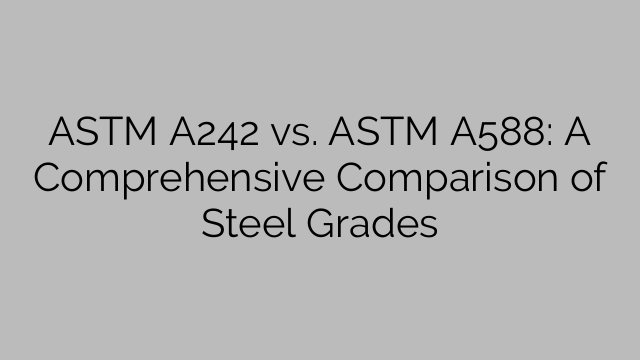ASTM (American Society for Testing and Materials) is an international organization that sets standards for various materials, including steel. Among its numerous standards, ASTM A242 and ASTM A588 are two commonly used grades of weathering steel. While they share some similarities, these steel grades have distinct features that make them suitable for different applications. This article aims to provide a comprehensive comparison between ASTM A242 and ASTM A588 to help readers understand the differences and select the appropriate grade for their specific needs.
1. Composition and chemical properties:
Both ASTM A242 and ASTM A588 are high-strength low-alloy structural steels that contain copper, chromium, nickel, and other elements. The presence of these alloying elements enhances the corrosion resistance of the steel and imparts their distinctive weathering characteristics.
ASTM A242:
ASTM A242 contains copper, chromium, nickel, and other alloying elements in trace amounts. It provides atmospheric corrosion resistance and has a minimum yield strength of 50 ksi (345 MPa). This grade is commonly used for constructional applications such as bridges, buildings, and railway rolling stock.
ASTM A588:
ASTM A588 contains additional alloying elements such as phosphorus, silicon, and vanadium. These elements enhance the mechanical properties of the steel and provide superior corrosion resistance. ASTM A588 has a minimum yield strength of 50 ksi (345 MPa) and is commonly used in applications exposed to harsh weather conditions, such as construction of bridges, towers, and outdoor sculptures.
2. Corrosion resistance:
One of the major advantages of weathering steel grades like ASTM A242 and ASTM A588 is their enhanced corrosion resistance compared to conventional steel grades. Both these grades form a protective oxide layer, known as a patina, when exposed to the atmosphere. This patina acts as a barrier to further corrosion, providing long-lasting durability.
ASTM A242:
ASTM A242 steel is renowned for its ability to withstand atmospheric corrosion. It forms a patina over time, which prevents the need for painting and reduces maintenance costs. However, it may not offer the same level of corrosion resistance as ASTM A588 in highly corrosive environments.
ASTM A588:
ASTM A588 exhibits higher resistance to atmospheric corrosion compared to ASTM A242. The addition of alloying elements in A588 steel enhances its corrosion resistance, making it suitable for harsh environments, including marine and industrial atmospheres.
3. Weldability:
Weldability is a crucial factor to consider when selecting the appropriate steel grade. Both ASTM A242 and ASTM A588 can be successfully welded using common welding methods; however, some precautions are required.
ASTM A242:
ASTM A242 can be easily welded using ordinary carbon steel welding electrodes. Preheating and post-weld heat treatment are recommended to prevent cracking and ensure the structural integrity of the welded joints.
ASTM A588:
ASTM A588 has similar welding characteristics to ASTM A242, but due to its higher alloy content, it may require preheating and stress-relieving treatments to prevent cracking and achieve proper weld quality.
In conclusion, ASTM A242 and ASTM A588 are two widely used weathering steel grades that offer enhanced corrosion resistance compared to conventional steel grades. While A242 is suitable for constructional applications, A588 is ideal for more demanding environments. Conducting a thorough analysis of the specific application requirements and consulting with experts can help determine which grade is best suited for a given project.

